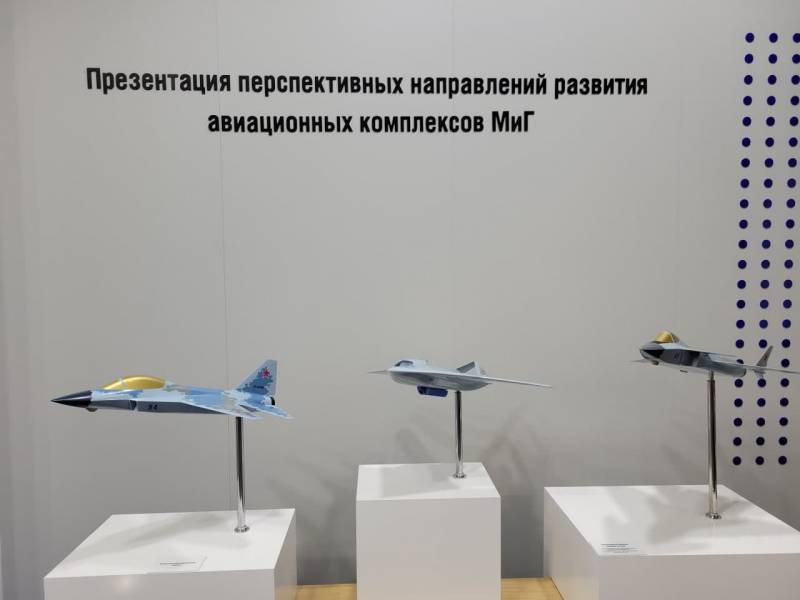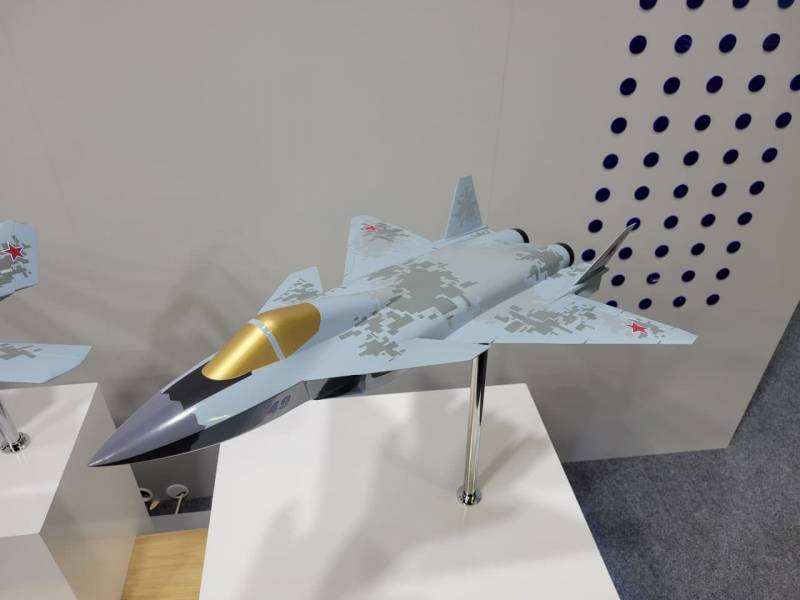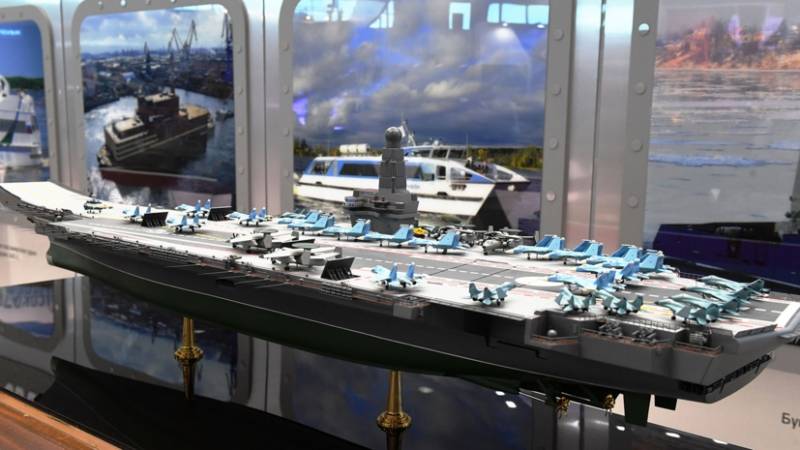Proposals and reality: project of carrier-based fighter from RSK MiG
Currently, only 4 generation fighters are in service with the Russian carrier-based aviation. In the medium term, the fleet of such aircraft will need a complete renovation due to physical and moral obsolescence. In this regard, for a long time, the issues of creating a carrier-based fighter of the next 5th generation have been studied. Recently it became known that RSK MiG is working on its own version of such a machine. Moreover, the aircraft is proposed to be supplemented with a highly efficient UAV.
Layouts and news
During the MAKS-2021 salon, MiG Corporation held a "presentation of promising directions for the development of aviation complexes." Three scale models of previously unknown aircraft became its central element. They were designated as "light multifunctional aircraft", "multifunctional shipborne fighter" and "multifunctional shipborne UAV".
The layouts made it possible to understand the general features of the proposed machines, but details were not available. In particular, the expected tactical and technical characteristics, combat capabilities, etc. were not specified. Information of this kind appeared the next day after the salon was closed. Already on July 26 RIA News told about new projects - information was provided by an unnamed source in the military-industrial complex.
It is reported that RSK MiG has begun development of a new 5th generation carrier-based fighter. At the moment, the project is at the stage of computer modeling, and the appearance of a prototype is expected over the next few years. Some technical and other details were also provided. The size of the aircraft will correspond to the existing MiG-35. The glider and other units will be built using stealth technology. The possibility of creating an aircraft with vertical take-off and landing is being considered.
In parallel with the fighter, a carrier-based UAV is being created - both vehicles will become part of a single aviation complex. A drone with a takeoff weight of more than 10 tons will work together with a fighter as a so-called. faithful follower. With its help, it is supposed to strike at various targets or carry out refueling in the air. When creating such a UAV, it is planned to use the experience of creating the Skat product.
Later, in early August, RIA Novosti revealed new details of the project, also obtained from anonymous sources. In addition to previous news reports, it was reported that the 5th generation fighter will have a number of distinctive features. So, he will be able to make a supersonic flight without using afterburner. with equal efficiency to work on ground and air targets, and the implementation of combat missions will be simplified through the use of artificial intelligence.
Possible appearance
The model of the aircraft, prepared for MAKS-2021, shows the possible appearance of the future carrier-based aircraft. We offer a glider with characteristic smooth and angular contours, built according to the "duck" scheme. Unlike other aircraft of this type, the wing is located not in the tail, but closer to the central part of the fuselage.
Provides a front horizontal tail of medium size and a swept wing with developed mechanization on both edges. The tail section is formed by two protruding engine compartments with a short beam between them, as well as small planes on which the collapsed keels and lower ridges are fixed.
On the flat bottom of the model, three hatches of the chassis niches are visible, as well as two large doors of the cargo compartments. The total length of the compartments can reach one third of the length of the aircraft; the transverse dimension is slightly less than the width of the fuselage. You can also assume the fundamental possibility of transportation weapons under the wing on removable pylons.
The power plant includes two turbojet engines of an unknown model. Perhaps, the project uses engines with a controlled thrust vector, which will give super-maneuverability - one of the hallmarks of the 5th generation. It is curious that the layout has no signs of a vertical takeoff aircraft.
Lead and follower
The layout shows that the new MiG will receive a bow radar station, probably with AFAR. Also noticeable is the ventral optical-location station with a characteristic faceted fairing. Possibly all-round visibility will be provided. Taking into account the requirements for the 5th generation, the use of advanced radio-electronic equipment for communication, data processing and control can be expected. An onboard defense system is also needed.
The lantern of the layout indicates the use of a "short" single cab. Accordingly, all the tasks of piloting, fighting, etc. one pilot will have to decide. At the same time, the fighter is planned to be used in conjunction with a controlled UAV - which will expand the range of tasks assigned to the pilot. As a result, there are special requirements for the on-board equipment of the aircraft, which must perform part of the work and unload the pilot.
Obviously, the "faithful slave" UAV will receive the most automated control system capable of independently performing a flight, solving combat and other tasks, and also reacting to some changes in the situation. At the same time, the leading aircraft also requires advanced computing facilities and software. The use of artificial intelligence, which helps the pilot in all situations and tasks, looks quite likely.
It should be recalled that artificial intelligence and "faithful followers" are actively developing, but they have not yet reached full use in combat aviation. However, in our country, a complex is already being developed in the form of a Su-57 fighter and an Okhotnik UAV. The developments in this project can also find application in the aircraft complex from RAC MiG.
Development prospects
Reportedly, the MiG carrier-based fighter project is still in its earliest stages. It is not known whether it will be possible to move to new stages and build a prototype in the coming years. So far, both positive and negative scenarios can be considered with equal probability.
It is obvious that the fate of all new projects of RSK MiG, shown in the form of mock-ups at the recent show, directly depends on the plans of the customer, represented by the Russian Ministry of Defense. If our command plans to develop carrier-based aircraft in the medium and long term, the project or projects can receive the necessary support. Thanks to this, a new aircraft or even a whole complex with a manned and unmanned vehicle will be able to appear.
Developing new technology will not be quick or easy. The media reported that the MiG corporation may build an experimental aircraft of a new type over the next few years. This means that even with a positive development of events, flight tests will begin only by the middle of the decade. Given the complexity of the project, we can expect the series to be deployed only in the first half of the thirties - if not later.
The future of the proposed UAV is directly related to the fighter. Self-development of such a machine for inclusion in the existing fleet of deck aircraft hardly makes sense. It must be carried out only in conjunction with a 5th generation fighter. With the successful completion of two projects, the Navy will have a unique complex with the widest capabilities, corresponding to the newest and most relevant trends in the development of combat aviation.
It should be borne in mind that the prospects for ship projects of RSK MiG and other aircraft building organizations directly depend on plans for the development of aircraft carrier fleet... The issue of building a new aircraft carrier has been discussed for many years, and there are even corresponding plans. However, their implementation is constantly shifting to the right, which also affects the prospects for the aviation sector.
Operations and orders
So far, new samples of carrier-based aircraft from RAC "MiG" exist only in the form of preliminary developments and exhibition models. The prospects of these projects are still in question and are directly related to the plans of the Ministry of Defense for the development of the fleet. What decisions and when will be made in this context is unknown. So far, only the most general plans and possible dates have been announced.
However, new projects from RSK MiG will have positive consequences regardless of the decision of the military department. First of all, they will help the corporation maintain competencies in the development of modern combat aircraft, as well as contribute to the development of new ideas and technologies for it. In addition, the groundwork for future projects will be created. And if the Ministry of Defense orders a new carrier-based aircraft or UAV, the industry will be ready to fulfill such an order in full and in the shortest possible time.





Information